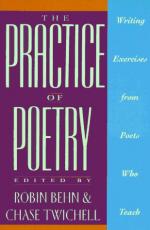
|
| Name: _________________________ | Period: ___________________ |
This test consists of 5 short answer questions, 10 short essay questions, and 1 (of 3) essay topics.
Short Answer Questions
1. What famous poet is referred to in "Rhapsodizing Repetitions?"
2. "Twenty Little Poetry Projects" offers what item to students?
3. "Shall We Dance?" refers to what technique?
4. How long will it takes students to complete the course used in "Writer's Block: An Antidote?"
5. In "Emotion/Motion/Ocean/Shun," the author teaches students about what topic?
Short Essay Questions
1. According to the author of this section, what is the most difficult task facing students?
2. What is the "Matthewsian Invisible Hinge?"
3. How is the technique used in "The Party of the Century" valuable as a group exercise?
4. Explain the tool used in "In a Dark Room: Photography and Revision" and how they can help students in their work.
5. What are the two basic structures used in "Truth in Strangeness: Accidents, Chance and the Non-rational?"
6. What is a nesting rhyme? How does it compare to a diminishing rhyme? Explain the technique.
7. What is the goal in the section titled "Stealing the Goods"?
8. What is an "imitative fallacy?" How is it used in poetry and by whom?
9. Explain the difference between factual and psychological truths.
10. Why does the author choose to use "A Lewis Carroll Carol" as a learning tool?
Essay Topics
Write an essay for ONE of the following topics:
Essay Topic 1
Explain the processes and steps involved in the section titled "Five Easy Pieces." Explain each of the seven steps in the exercise and why it each is important as a stand alone and as a contribution to the whole work. Would the poem work without one of the steps? If so, which one? Explain.
Essay Topic 2
In the section titled "In a Dark Room: Photography and Revision" students are required to derive a poem from a photographic image. Explain the artistic and psychological connections between the photograph and the poem. How is the character of one transferred to the other? How should one interpret this exercise so that it would be the most effective?
Essay Topic 3
In "The Widow" students are required to write through the eyes of a woman whose husband has recently drowned. Explain in detail how you would put yourself in the widow's shoes? What techniques might you employ to create a complete and believable character study of the widow? Would your writing experience be easier or more difficult if you had experienced the same tragedy?
|
This section contains 704 words (approx. 3 pages at 300 words per page) |

|




